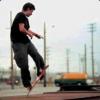yes nice. you can keep it like that, only you need to display names rather than numbers in the sprite buttons. you can't give that editor to anybody else than you in this state.
a bit of rebound for the ball ? multiple times I felt that the lack of rebound was disturbing.
what is the plan for the next ?
Yeah, using numbers is confusing, but I kept them because the idea is that people modify the images to their liking (the images in the video are just quick drawings I made in MS Paint). But I could add something to let people modify what each button says in a future version or something, because is indeed unconfortable to use numbers.
About the rebound, the ball is just a placeholder for the player character. Indeed it looks weird without rebound, but a player character (let's say, a human) will look weird as well if it bounces after touching the ground or something  . Still, thanks for the observation, I'll keep it in mind.
. Still, thanks for the observation, I'll keep it in mind.
And asuming you meant what's next for a new version, I honestly don't know. I made this during summer break, and I'll go back to college this monday, so I won't have time to keep making it. :/
Thanks for your feedback.
Very nice! What did you use to record the YouTube video?
You said: "It's nothing extraordinary in comparison of other projects on this forum that are pure awesomeness"
I fully support giving that video the label "pure awesomeness". Congrats on bringing it this far!
You asked for suggestions, so here's a few:
------------------------------
It looks like your workflow could be improved somewhat - that editor may prove a bit tedious to use as-is.
My suggestion would be that when holding SHIFT or CTRL or some other key, and placing nodes, it automatically connects them to the last node placed at the same time.
This way, you can go:
(holding shift) click, click, click, click, click, click.
Instead of:
Switch to node placement, click, click, click, click, click, click
Switch to node connection: (clickity - click), (clickity- click), (clickity- click), (clickity- click), (clickity- click), (clickity- click)
For the same reason, I like placing multiple tiles by clicking and moving the mouse, instead of clicking once per tile.
Another suggestion would be to add spline support in addition to your existing flat-lines.
A third suggestion would be creating placeholders, so you can place a balloon down AND automagically place down the balloon collision lines, so you don't have to make the same collision lines for every single balloon you put down, or the same collision lines for every single tree.
------------------------------
Overall, very nice work! You should create a GameDev.net Journal so we can see your editor and game progress more into even purer awesomeness.
Thanks for the kind words, I really appreciate them 
To record I used Fraps. The resulting video was quite large so I used Virtual Dub to compress it.
Thanks for your suggestions as well. I know is tedious to use as-is, but I couldn't work on it more due to, like I said, I'm entering college and I want to rest these two days left. I'll try to implement your suggestions in the mean time.
I'm considering getting rid of the tiles for the background and just use sprites, like the player character. That way I can put, let's say, the balloon on any position with pixel-precision instead of being limited to the grid, AND I could make it add the collision line automatically, like you suggested. That would be neat, and would make the editor very flexible and fast.
My ultimate goal, however, is to try to create huge maps efficiently, because I want to make an "open world platformer" to see if it works. The map right know is 100x100 tiles, but I can make it to 10000x10000 easily, "only" consuming like 200 MB of Ram for the map. The problem is, using tiles the editor is very optimized, but if I made the switch to normal sprites, I honestly have no idea of how to make it efficient and keep the memory usage low. But I'll figure it out, hopefully.
I'll consider keeping a journal, thanks, though I prefer using videos for now. There is nothing more motivating that watching your little baby grow 
Thanks for the feedback and suggestions :)








